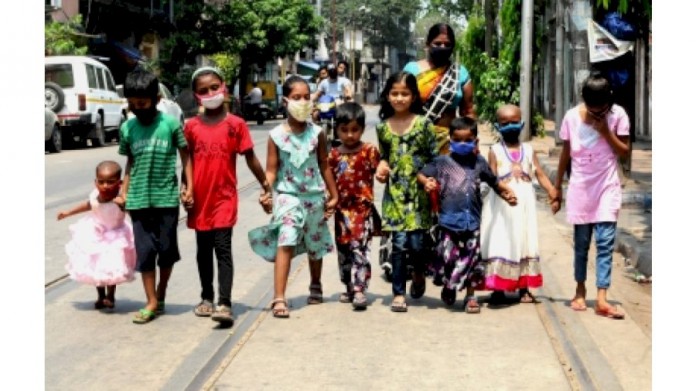University of East Anglia led research reveals that gender and wealth-driven disparities continue to negatively impact Indian children’s educational outcomes, despite recent government policy reforms
According to new research from the University of East Anglia (UEA), children from poorer households consistently experience educational disadvantages compared to their wealthier peers, and girls are more adversely affected than boys. Researchers from UEA and the University of Birmingham, which partnered on the project, said their findings highlight the limitations of the current education policy and called for more comprehensive reform.

Important Announcement – EasyShiksha has now started Online Internship Program “Ab India Sikhega Ghar Se”

Their report, ‘Picking winners: An empirical analysis of the determinants of educational outcomes in India’, is published today in the British Educational Research Journal.
The research was conducted jointly by Dr Nicholas Vasilakos, a lecturer in International Business in the Norwich Business School at UEA and Dr Christian Darko, a lecturer in Applied Business and Labour Economics at the Birmingham Business School of the University of Birmingham.
The project used data from the Young Lives longitudinal survey to analyse the effect of socioeconomic conditions and gender on the educational performance of young children in India.
Data was drawn from standardised scores on two cognitive tests: the Peabody Picture Vocabulary Test (PPVT) and a maths test, and the researchers looked at results from 951 children from the regions of Andhra Pradesh, Rayalaseema and Telangana.
Dr Vasilakos said: “India has undergone a period of rapid modernisation across all areas of social and economic activity – including education.
“Despite recent policy reforms in boosting enrolment rates and improving access to education, there are still substantial gender- and wealth-driven disparities affecting the educational progression of young children in India.
Top Courses in Software Engineering
“Our results show that children from wealthier households consistently outperform their less-affluent peers.
“There are also significant gender differences in the way household wealth affects the educational performance of children. Specifically, boys born into wealthier households perform considerably better in maths than those from worse-off economic backgrounds. The effect of wealth on the PPVT – which measures verbal ability and general cognitive development – is stronger for girls than it is for boys.
“We also find that high caregiver aspirations are positively and significantly associated with better performance in math, for boys but not for girls.”
Children from wealthier households have fewer constraints – such as the cost of books, school fees or uniforms – and no need to work for income or perform household chores, as their less-affluent peers often must. Additionally, children from poorer households may only have access to substandard schools and resources, and less parental support with their education. They are also more susceptible to adverse economic shocks, which may in turn force parents to make choices about which child to send to school – or indeed, to choose between work and an education.
Dr Vasilakos and his colleague at Birmingham, Dr Christian Darko, said the importance of early life education is a determinant of later-life success. Moreover, additional policy reforms need to consider gender differences in access to education as well as employment opportunities, and tackle issues related to gender bias both in schools and the workplace.
Dr Vasilakos said: “Educational policy reforms may not be able to fully achieve their objectives, unless they are accompanied by economic policies that address issues of inequity and inequality.
“Such policies should aim to economically empower poorer households to reap the benefits of educational reforms by making them less reliant on their children’s income for survival, whilst improving schooling quality, especially in areas where children from poorer households are likely to be over-represented.
“Until these changes happen, India will be limiting its economic and developmental potential.”
‘Picking winners: An empirical analysis of the determinants of educational outcomes in India’, is published 10 July 2020 in the British Educational Research Journal.
For more information related to technology, visit HawksCode and EasyShiksha
Empower your team. Lead the industry
Get a subscription to a library of online courses and digital learning tools for your organization with EasyShiksha
Request NowQ. Are EasyShiksha's internships truly free?
Yes, all internships offered by EasyShiksha are completely free of charge.
Q. How can I apply for an internship with EasyShiksha?
You can apply by visiting our website, browsing available internships, and following the application instructions provided.
Q. What types of internships are available through EasyShiksha?
EasyShiksha offers a wide range of internships across technology, business, marketing, healthcare, and more. Opportunities are continuously updated.
Q. Will I receive a certificate upon completing an internship?
Yes, upon successful completion, you will receive a certificate recognizing your participation and achievements.
Q. Are EasyShiksha's internship certificates recognized by universities and employers?
Yes, the certificates are recognized by universities, colleges, and employers worldwide.
Q. Is the download of certificates free or paid?
Access to internships and courses is free, but there is a small fee to download certificates, covering administrative costs.
Q. When can I start the course?
You can choose any course and start immediately without delay.
Q. What are the course and session timings?
These are fully online courses. You can learn at any time and pace. We recommend following a routine, but it depends on your schedule.
Q. What will happen when my course is over?
After completion, you will have lifetime access to the course for future reference.
Q. Can I download the notes and study material?
Yes, you can access and download course materials and have lifetime access for future reference.
Q. What software/tools would be needed for the course?
All necessary software/tools will be shared during the training as needed.
Q. I’m unable to make a payment. What should I do?
Try using a different card or account. If the problem persists, email us at info@easyshiksha.com.
Q. Do I get the certificate in hard copy?
No, only a soft copy is provided, which can be downloaded and printed if required.
Q. The payment got deducted but shows “failed”. What to do?
Technical errors may cause this. The deducted amount will be returned to your account in 7-10 working days.
Q. Payment was successful but dashboard shows ‘Buy Now’?
Sometimes payment reflection is delayed. If it takes longer than 30 minutes, email info@easyshiksha.com with the payment screenshot.
Q. What is the refund policy?
If you face technical issues, you can request a refund. No refunds are issued once the certificate has been generated.
Q. Can I enroll in a single course?
Yes, select the course of interest, fill in the details, make payment, and start learning. You will also earn a certificate.
Q. My questions are not listed above. I need further help.
Contact us at info@easyshiksha.com for further assistance.
ALSO READ: Boltt-play-indias-tik-tok-app-rewards-users-content-creators
Get Course: Mobile-Apps-Development-using-React-Native








































































